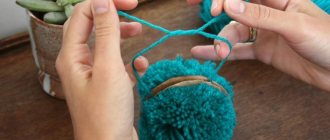Hello dear readers! Today we will weave violets from beads. Beading is a labor-intensive process, but the result is worth it. You can make plants and animals, bracelets and necklaces, and even toys. But today we will make one of the indoor plants - violet. Let's start by preparing everything you need for weaving.
Tools and materials Time: 4 hours • Difficulty: 5/10
- Copper wire 0.3 mm;
- Green beads for leaves – 50 g;
- Yellow beads for stamens – 5 g;
- Blue beads for petals (other colors can be used) – 10 g;
- Scissors (you can use pliers);
- Pot for planting;
- Foam for fixation;
- Floral green ribbon to decorate the stem;
- Lace fabric – 10×10;
- Thread with beads – 10 cm;
- Ribbon – 15 cm.
A step-by-step photo will accompany each step in the beaded violet master class. To make it clear even to those who have never done it.
Video lesson:
Violet woven from beads
To start working on creating a violet we will need:
- green, pink and yellow beads;
- wire 0.2 mm;
- a pot for placing a bouquet;
- gypsum-based putty.
We collect three beads using a meter-long wire and make a loop out of them, which will be the base of the petal. Next, beads are collected for the next loops. When the petal is ready, the remaining petals are made on the same wire, of which there must be five pieces. Next, the center of the flower is formed from yellow beads. The ends of the wires are twisted - and the flower is ready. Then leaves are made from green beads.
Beaded violets for beginners, master class with step-by-step photos.
Step 1: flower
- Measure 45 cm of wire and put on 5 pieces. blue or any other color. Move to the middle and connect, you should get a circle, as in the photo. Fasten a few turns.
- String 13 more onto one end, circle around a small circle and connect to the other end. Fasten in the same way as in the first case.
- Take another 18, circle the petal and secure. You will get one petal.
- Repeat for the other 3 petals as well.
- You will need 7 pcs.
The number of beads strung on the second and third circles may vary depending on the size of the beads. Therefore, before fastening, check by attaching the wire with beads to the place of fastening. If there is still room, then add, if on the contrary there is a lot, remove.
Step 2: Stamen
- Measure 15 cm of wire and string 4 yellow ones. Slide them to the middle and tighten.
- Thread 2 more ponytails at the same time.
- Connect the stamen to the flower.
Step 3: leaves
We will need leaves of 3 sizes.
- Measure 45 cm of wire and string 16 pieces. Green colour. Move to the middle.
- Pass the other tail through the same beads. Both tails should be peeking out from one end, and there should be a loop on the other.
- Next, put 20 on one of the ends and wrap it around the loop.
- On the same part, string another 20 and secure.
- Put 25 on the other end and repeat the action. A large sheet is ready, 3 of these are needed.
- For medium size, take 10 pcs. Repeat the same as in the first case. Increase the beads by 3-4 on each new arc. You will need 4 of these.
- For a small one you will need 8 pcs. Do the same for large and medium-sized leaves. Make 3 small ones.
Step 4: decorate the stems
- Use floral tape to tie a small knot at the very beginning of the stem. Wrap the stem, trim off the excess part.
- Do the same with the other stems.
Step 5: attach to the pot
- Gather everything together and connect it with a ribbon, tie it.
- Make a hole in the foam to thread the stems through.
- Insert into this hole.
- Plant the bouquet in a pot.
These are the beautiful beaded violets we made for beginners! Below we invite you to see tips on beading, as well as a master class on beaded violets for more experienced craftswomen. Hope you enjoy!
Useful tips
- Storing beads in the bags in which you purchased the product is not very convenient. Packages often open and all the contents spill out into different corners. To avoid such an unpleasant incident, store beads in plastic and glass containers. Use baby food jars, bad/tablet holders, gouache jars.
- If the beads fall apart, don’t worry, there are several ways to quickly put everything back together. For example, it is convenient to assemble with a wet hand, but it takes a long time. You can also use tape for this, but it will take even longer. The fastest way to collect the contents of the bag is with a vacuum cleaner. Remove the nozzle and instead push a nylon sock or stocking into the pipe, after you have collected the “lost”, lift the pipe vertically and turn it off. All the collected goods will be in the sock.
- Store your finished work in a separate box. In general, if you aim to create constantly, then you will have a lot of such works. And to prevent them from lying around the house, the best option for them is a box. Then they will be safe and sound. If you want to show them to someone, you won’t need to look for them, they will always be at hand.
- Many beginners are tormented by the question - “how to complete the work so that it does not unravel?” It’s very simple, if you work with wire, you need to make a bundle and decorate it. If with a thread, then just tie a few small knots, passing them back through a few beads, and your work will serve for many years. The situation is different with fishing line. When working with it, it is not enough to tie a knot, and you won’t be able to make a tourniquet at all. You can use a lighter to burn the ends, or colorless nail polish to paint over the knot.
- When working with thread, avoid knots. They prevent the passage of beads, and the work as a whole does not look aesthetically pleasing. When working with fishing line, they are easy to untie, but with thread, you have to cut them.
- The quality of the beads plays a very important role in creating the perfect work. If you are just starting out, then you can get by with ordinary Chinese, Taiwanese, Indian or Turkish beads; they are not particularly distinguished by the evenness and strength of the material. But for training and for initial creations it will do, in the price range it is quite cheap. Czech is more durable and smooth, as for the price, it is more expensive. Czech beads have a beautiful palette of shades; if you intend to continue making your masterpieces, then be sure to try it. There is also a Japanese one, it has several lines. Most reviews say that it is a pleasure to work with. Indeed, if you are ready to create, then you can work with any material. Japanese beads are more expensive than the previous ones, and they differ in quality. The beads are smooth, strong and identical. It is more suitable for making jewelry.
- Tools are also necessary for work. There are special needles for working with beads. They are distinguished by a smooth surface along the entire length. This needle is very thin and therefore it often bends and breaks. Therefore, it is advisable to keep several of these on hand, or better yet a package. Special needles can be purchased both in needlework stores and specialized beadwork departments.
- How to calculate the required quantity. Weight is often written in diagrams in grams, but few people know exactly how much. And in stores they sell beads in bags, which are measured in grams. On average there are 100 pieces in one gram. if you are working according to a scheme in which the exact quantity is indicated, then simply divide it by 100 and you will find out how many grams you need for the work.
- If you want to embroider fabric, it is better to use Japanese or Czech beads. The quality of Chinese will not give you the desired result. Chinese beads will break, and the process of creating the canvas will take a long time, or you will be disappointed in your abilities.
- If you picked up an extra bead when making a canvas or other product, but have already secured this place, what should you do in this case? You can easily solve the problem by using pliers or thin-nose pliers and crush it. The thread can be tightened and it will not spoil the look.
- How to determine the quality of a material. There are several ways to determine whether a product is actually good or not. Rub a few beads in your hands, if the color does not darken, then everything is fine. You can also put it in the sun, if the quality is good, the color and strength will not be affected. The surest way is to put them in washing powder with bleach for a day.
This is where the advice ends, I wish you to create magnificent masterpieces. And don't stop creating!
Flower
We put several meters of beads onto the wire at once so that we can weave our petals and flowers one after another. Let's step back 10-11 cm from the edge of the wire and make the first loop of 7 beads.
We turn the loop around its axis 2 times (and henceforth make sure that all the turns are in the same direction). We move the required amount of beads from the main wire and make a second loop, as close as possible to the first.
Scroll 2 times, similarly make a third loop and scroll 4 times.
We have the first petal ready, and the flower should have five of these. We retreat 1-1.2 cm and make a second loop and the petal itself.
We repeat all steps until we have 5 petals.
We make six more such blanks. Small petals are made according to the same principle.
- As a result, you should have seven large and seven small petals.
- Stamens
- Each stamen blank consists of 5 yellow beads.
- There are seven such blanks in total.
- Let's start assembling the flower
Leaves
We weave a stepped petal: we make a frame blank for a small leaf. To do this, we need a piece of wire 13 cm long and a second piece 85 cm. We make a tight twist of them 10 cm long (you should have a short “tail” of about 3 cm (this is the axial wire - the axis) and a long wire with a free edge, on We will use it to collect beads (working wire).
- We collect 6 dark-colored beads on the axis and make the first pair of arcs with dark beads.
- We make the second pair of arcs with the addition of light beads at the top of the future leaf.
- In the third pair of arcs we add even more light beads.
We begin to make “steps”: we make the first one without reaching 5-6 beads to the top of the sheet. We measure out the required amount of beads (remove the excess), pass the wire from the inside to the front part of the sheet.
- We collect 7-8 light beads and the required number of dark ones, return to the base of the sheet and make one turn around the axial wire (we place the working wire between the last and penultimate rows, and not under the last as usual).
- We weave the second side of the leaf in the same way.
The small leaf should have only 4 “steps” on each side. When making “steps”, be guided not by the number of beads (how much to retreat), but make sure that the “steps” are approximately at the same level.
- We make five such leaves.
For a large leaf, we make frame blanks from pieces of wire 15cm and 1m long. We make a twist of about 11 cm, a free “tail” of about 4 cm.
- We collect 7 dark beads on the axis and make the first pair of arcs.
- Then everything is the same as for a small piece of paper.
- A large leaf will have 5 “steps” on each side.
- Now all the blanks are ready.
We decorate all the stems with floral ribbon. We give the desired look to the flowers and leaves.
Assembly
We plant the bush in a pot and fill it with plaster. After complete drying, decorate with sisal or other decorative elements.
Our violet is ready!
We admire and are proud of ourselves! We wish you pleasant creativity! Evgenia Volkova
Author's group: “Tree of the Soul. Creative workshop"
Source: https://melodiabisera.ru/workshops/master-klass-fialka-iz-bisera/
Beaded violets master class
Weaving beads is a fascinating activity. It develops imagination and perseverance skills. This painstaking task not only brings pleasure, but also calms the nerves in the process. Try making violets from beads in a more complex version. In this version, the leaves are different; they are not round, but pointed. For convenience, each action will be accompanied by step-by-step photos. Prepare all the necessary materials and tools that you need for making.
Step-by-step instruction
Step 1: making flowers
- Weave flowers just like in the first master class, you will need 7 of them.
Step 2: Stamen
- Repeat step 2 of the master class for beginners to make a stamen.
Step 3: Leaves
- Cut 60 cm of wire and put 31 beads on it.
- Tighten the ends in the last bead.
- Use one of the ends, string 16 beads and thread through the last one. For convenience, look at the photo.
- Next, put another 19 on it and pass through the last bead.
- Pass another 15 through the 15th.
- Using this part, take 18 and push it through the last one.
- After stringing 10 more, pass through the 10th.
- Put another 13 on it and push it through the last one. Half is ready.
- Repeat for the other half too.
- Make 10 pcs.
Try to select beads of the same size, otherwise try on a thread with beads to make it look approximately the same. If there are a lot of beads, then remove a few; if, on the contrary, there are not enough beads, add them.
Step 4: registration
You can arrange it not only in a pot, but also beautifully package it in paper or fabric, as in this case.
- Collect everything.
- Fold the lace fabric in half and wrap it around the bouquet.
- Draw a thread with beads around the bouquet so that it peeks out beautifully from under the leaves.
- Tie the bouquet with a bow.
We hope our master classes have dispelled all your doubts and questions about how to weave violets from beads. Below we also invite you to watch several video master classes that will show you the entire weaving process even more clearly.











